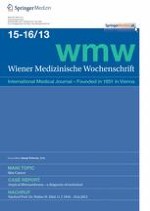01.08.2013 | case report
Atypical fibroxanthoma—a diagnosis of exclusion!
Erschienen in: Wiener Medizinische Wochenschrift | Ausgabe 15-16/2013
Einloggen, um Zugang zu erhaltenSummary
Fibrohistiocytic tumors of the skin comprise a large range of lesions. One such tumor is the atypical fibroxanthoma (AFX), which is widely considered as a “pseudomalignant” tumor. It is derived from fibroblasts and expresses a variety of histiocytic markers. We present a case of AFX, localized in the right temporal region of the scalp, successfully treated with surgical excision. Immunohistochemical staining helps differentiate this tumor from others in the clinical differential diagnosis, including malignant melanoma, squamous cell carcinoma, and other nonmelanocytic spindle cell tumors such as leiomyosarcoma, rhabdomyosarcoma, angiosarcoma, liposarcoma, and dermatofibrosarcoma protuberans. Historically, AFX was believed to be a superficial variant of malignant fibrous histiocytoma (MFH). However, MFH is now considered a more generalized term for a sarcomatous neoplasm of the subcutaneous tissue. The histopathology of MFH shares features with some malignant mesenchymal neoplasms such as liposarcoma, leiomyosarcoma, rhabdomyosarcoma, and angiosarcoma, but can be differentiated using immunohistochemistry and/or electron microscopy. More recently, the examples of MFH that do not exhibit a more specific line of differentiation have been reclassified as undifferentiated pleomorphic sarcoma (UPS). Many authors currently cannot draw a distinction between AFX and UPS. The clinical and histopathological differences between AFX and UPS are often difficult to delineate. It is probable that they represent two poles of the same disease. Surgical excision in the patient we describe resulted in excellent aesthetic results with lack of recurrence in the 7-month postoperative period.
Anzeige
